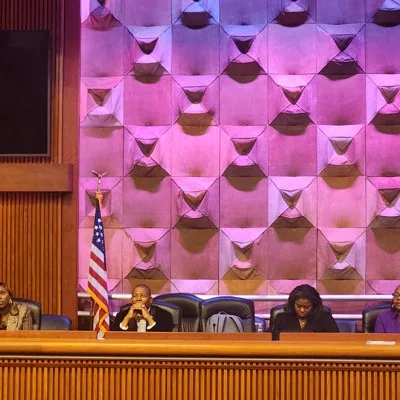
On Saturday, lawmakers and policy experts urged Black New Yorkers to offer as much input as possible ahead of the formation of a state commission on reparations. At a New York State Association of Black, Puerto Rican, Hispanic and Asian Legislators conference panel, state lawmakers talked about what should and shouldn’t be included in New York’s reparations plans, but there is no current timeline for the commission’s creation. While the debate was raucous at times, attendees shared the common stance that something should be done to heal the wounds of slavery.
Gov. Kathy Hochul signed a bill in December that would create a commission to study reparations and the effects of slavery on Black New Yorkers. The legislation put forth by state Sen. James Sanders Jr. and Assembly Member Michaelle Solages built on years of growing support for such a commission and allows for a nine-member commission made of political appointees to issue recommendations for reparations. The bill was passed in June 2023 on one the final days of the legislative session.
Saturday’s panel served as proof that there was no universal idea of what reparations should look like. However, lawmakers entertained the exploration of different schools of thought – direct cash payments versus community investments – in the hopes the commission would have a base of public sentiment to build from.
As Brooklyn NAACP President L. Joy Williams put it, “There needs to be that conversation and communication about what remedies can actually be. And we have all what we need in our communities, in our brains, in our minds, and the more we talk about it, we can develop collectively a better pathway forward.”
Williams added that in the interest of time, it was important for Black New Yorkers to engage with their local history and try to account for all that white people had taken from their communities. She said rather than have the commission take months studying the effects of slavery on Long Island, for example, that information could be shared with them as they developed recommendations.
She was joined by Sanders and Solages, New York City Council Member Farah Louis, state Sen. Robert Jackson, Assembly Member Stefani Zinerman and Assembly Member Khaleel Anderson.
Zinerman offered some of her own ideas on what reparations could look like, providing examples of forgiven mortgages and free tuition, even signaling her support for an idea to negate property taxes for Black New Yorkers that someone from the crowd suggested. She said reparations need to account for three “pots” of disenfranchisement of Black New Yorkers: slavery, segregation and the ongoing specter of racism.
“So technically even though we’re talking about $14 trillion for the enslavement, the meter is still running,” Zinerman said.
In California, the state’s reparations task force issued its final report last year, and a member of the task force, Lisa Holder, told City & State last year that reparations should have five key components: compensation, restitution, apologies or atonement, guarantees of nonrepetition and rehabilitation. California’s report is of the few examples that New York could look to as a starting point for its own plan.
At Saturday’s event, members of the crowd were unruly at some points, disagreeing loudly with lawmakers’ takes on what the commission could do, with the primary gripe being the lack of commitment to financial reparations in the bill’s language. Sanders and Zinerman were quick to remind attendees that only they had microphones and should be speaking.
Toward the close of the panel, Sanders said he planned to tour the rest of the state to share more information about reparations and gather feedback from New Yorkers. He said he was in contact with some of the people who could be selected for the commission but nothing was definite, even joking that Hochul might have missed a great recruitment opportunity that weekend.
“I have suggested to the governor that the best time would have been during the gala on Sunday,” Sanders said. “You have thousands of Black folks sitting whenever that would be a perfect time.”

